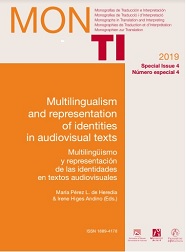Subtitling the profusion of the « human secretions » in Jacques Tati’s Playtime: a major challenge
Main Article Content
Abstract
Downloads
Article Details
The documents contained in these directories are included by the contributing authors as a means to ensure timely dissemination of scholarly and technical work on a non-commercial basis. It is understood that all persons copying this information will adhere to the terms and constraints invoked by each author's copyright. These works may not be reposted without the explicit permission of the copyright holder.
References
Chiaro, Delia. (2009) “Issues in audiovisual translation.” Dans: Munday, Jeremy (éd.) 2009. The Routledge Companion to Translation Studies. Londres & New York: Routledge, édition révisée, pp. 141-164.
Chion, Michel. (2009) Jacques Tati. Paris: Cahiers du cinéma.
Cornu, Jean-François. (2011) “Le public? Quel public? De l’influence négligeable des spectateurs sur les stratégies de traduction audiovisuelle des films en France.” Dans: Şerban, Adriana & Jean-Marc Lavaur (éds.) 2011. Traduction et médias audiovisuels. Villeneuve d’Ascq: Presses Universitaires du Septentrion, pp. 21-35.
De Linde, Zoé & Neil Kay. (1999) The Semiotics of Subtitling. Manchester: St. Jerome Publishing.
Díaz-Cintas, Jorge. (2005) “Back to the Future in Subtitling.” Dans: MuTra: Challenges of Multidimensional Translation. Saarbrücken: EU High Level Scientific Conference Series. Version électronique: https://www.euroconferences.info/proceedings/2005_Proceedings/2005_proceedings.html
Dondey, Marc. (2002) Tati. Paris: Ramsay.
Ede, François & Stéphane Goudet. (2002) Playtime. Paris: Cahiers du cinéma.
Etiemble, René. (1994) Parlez-vous franglais? Édition révisée. Paris: Gallimard.
Fieschi, Jean-André. (1996) La voix de Jacques Tati. Mulhouse: LimeLight.
Georgakopoulou, Panayota. (2009) “Subtitling for the DVD Industry.” Dans: Díaz-Cintas, Jorge & Gunilla Anderman (éds.) 2009. Audiovisual Translation: Language Transfer on Screen. New York: Palgrave Macmillan.
Gottlieb, Henrik. (1994) “Subtitling: Diagonal Translation.” Dans: Perspectives, Studies in Translatology 2:1, pp. 101-21.
Goudet, Stéphane. (2002) Jacques Tati: de François le facteur à Monsieur Hulot. Paris: Cahiers du cinéma.
Guerand, Jean-Philippe. (2007) Jacques Tati. Paris: Gallimard.
Laufer, Laura. (2002) Jacques Tati. Paris: Les Éditions de l’If.
Lavaur, Jean-Marc, & Adriana Şerban (éds.) (2008) La traduction audiovisuelle. Bruxelles: De Boeck.
Pérez-González, Luis. (1998) “Audiovisual translation.” Dans: Baker, Mona & Gabriela Saldanha (éds.) 1998. Routledge Encyclopedia of Translation Studies. Londres: Routledge.
Prédal, René. (2007) Esthétique de la mise en scène. Condé-sur-Noireau: Cerf-Corlet.
Self, Robert T. (2001) Robert Altman’s Subliminal Reality. Minneapolis: University of Minnesota Press.
Thoret, Jean-Baptiste. (2006) Cinéma contemporain. Mode d’emploi. Paris: Flammarion.
Toury, Gideon. (1983) “Sharing Relevant Features: An Exercise in Optimal Translating.” Meta: journal des traducteurs 28:2, pp. 116-129.
Filmographie:
Jour de fête (Jacques Tati 1949)
Les grandes heures: “Un comique de vocation: Jacques Tati” (Ina/Radio France 2009)
Les Quatre cents coups (François Truffaut 1959)
Les Vacances de Monsieur Hulot (Jacques Tati 1953)
Parade (Jacques Tati 1974)
Playtime (Jacques Tati 1967)
Playtime (Jacques Tati 1967 / BFI 2010).
Playtime (Jacques Tati 1967 / Studiocanal 2014)


